STAYING ALIVE
IN AVALANCHE TERRAIN

second edition
STAYING ALIVE
IN AVALANCHE TERRAIN
Bruce Tremper

TO BILL AND BARBARA TREMPER

1001 SW Klickitat Way, Suite 201, Seattle, WA 98134
2008 by Bruce Tremper
All rights reserved.
First edition, 2001. Second edition: first printing 2008, second printing 2009, third printing 2009
No part of this book may be reproduced in any form, or by any electronic, mechanical, or other means, without permission in writing from the publisher.
Published simultaneously in Great Britain by Bton Wicks, London
Distributed by Cordee, www.cordee.co.uk
Manufactured in the United States of America
Copy Editor: Erin Moore
Illustrations: Gray Mouse Graphics
Cover, book design, and layout: Peggy Egerdahl
All photos by the author unless otherwise noted
Cover photograph: Andrea Binning releases a slab avalanche on her second turn from the ridge top of the Coast Mountain Range near Mount Waddington, BC. Mark Gallup.com
Frontispiece: Snowbird avalanche expert Dean Cardinale with his avalanche search dog, Midas, on a search for two backcountry snowshoers who were killed in an avalanche they triggered. Neither snowshoer wore a beacon; the only way to locate them was with avalanche dogs and probes. (Wasatch Range, Utah)
Back cover photo: Author doing field work
Library in Congress Cataloging-in-Publication Data
Tremper, Bruce, 1953-
Staying alive in avalanche terrain: how the pros keep themselves and others alive / by Bruce Tremper.2nd ed.
p. cm.
Includes bibliographical references and index.
1. MountaineeringSafety measures. 2. AvalanchesSafety measures.
I. Title.
GV200.18.T74 2008
796.9028'9dc22
2008027104
 Printed on recycled paper
Printed on recycled paper
CONTENTS
ACKNOWLEDGMENTS
If you like this book, please dont thank me; Im just the messenger. Most of the ideas in this book came from the pioneers of avalanche research and education, which started in the United States with Ed LaChapelle, Monty Atwater, and Ron Perla, who ran the Alta Study Center from just after World War II to 1972. Together, they came up with the bulk of what we now teach in modern avalanche schools, as well as most of the techniques now used in avalanche forecasting, control, and rescue.
As you will notice, the names of my mentors, Doug Fesler and Jill Fredston, come up repeatedly in this book, and for good reason. Doug Fesler has lived among the big Alaska avalanches for 40 years. He started the Alaska Avalanche School in the early 1970s; he was joined by Jill Fredston, now his wife, in the early 1980s. Together they now run the Alaska Mountain Safety Center. As near as I can tell, they know more about avalanches and more about teaching avalanches than anyone else in the world. Most of the organization and presentation of avalanche concepts in this book were pioneered and refined by Doug and Jill through hundreds of multiday avalanche courses.
Special thanks for the hard work of the manuscript review committee:

Thanks also go out to the many people who have made significant contributions to this book but, for various reasons, were not able to review the manuscript. Those include (in alphabetical order): Ed Adams, Duain Bowles, Bob Brown, Howard Conway, Rand Decker, Kelly Elder, Jill Fredston, Andy Gleason, Hans Gubler, Clair Isrealson, Janet Kellam, Nick Logan, Dave McClung, Art Mears, John Montagne, Halstead Morris, Ron Perla, Doug Richmond, Don Sharaff, Grant Statham, and Chris Stethem.
The second edition was reviewed by Karl Birkeland, Ian McCammon, and Ron Johnson, and thanks to Erin Moore for her wonderful editing.
INTRODUCTION
Its so wonderful finding out you were wrong, that you were ignorant, that you know nothing, not squat. You get to start over.
Rick Bass
WHAT HAPPENS WHEN YOU GET CAUGHT IN AN AVALANCHE?
It was November 1978. I was a cocky, ex-national-circuit ski racer, 24 years old, fresh out of college, and because I needed the money I was building chairlifts at Bridger Bowl Ski Area in Montana. In the ignorance and vigor of youth, I naturally enough considered myself to be an avalanche expert. I had grown up in the mountains of western Montana where my father had taught me about avalanches when I was 10 years old, and I had skied in the backcountry the past several years and had so far avoided any serious mishaps. In other words, I was a typical avalanche victim.
I was skiing alone (first mistake) and not wearing a beacon (second mistake). After all, I wasnt skiing, I was working, tightening the bolts at the base of each chairlift tower with a torque wrench. Even in my stubborn ignorance, I could see that it was clearly very dangerous. Over a foot of light snow had fallen the night before on top of fragile depth hoar and the wind was blowing hard, loading up the steep slopes beneath the upper section of the chairlift with thick slabs of wind-drifted snow.
Starting from the top, I skied down, stopping at each tower to torque the bolts. When I was finished with the tower at the top of the avalanche paths, I took off my skis and started walking back up the slope so I could gain the ridge and circle around to the tower beneath the avalanche paths. But I quickly discovered my third mistake. Since I didnt bring my backcountry skis or climbing skins, the easy ski down was now an exhausting pig wallow back up through chest-deep snow, and the nearby snow-free cliffs were too scary to climb in my slippery plastic boots. I couldnt help but notice that only a 15-foot-wide couloir at the base of the cliffs separated me from the safe slopes on the other side. Naturally enough, I thought a good skier like me should be able to get up speed and zip across it before anything too bad happened. (Ski cutting alone and without a beacon or partnerfourth mistake.)
I did my ski cut according to the book. I built up speed and crossed the slope at about a 45-degree angle so that, in theory, my momentum would carry me off the moving slab, in case it did break on me. Since I had never been caught in an avalanche before, I had no idea how quickly the slabafter it shatters like a pane of glasscan pick up speed. I heard a deep, muffled thunk as it fractured. Then it was like someone pulled the rug out from under me and I instantly flopped down onto the snow, losing all the precious speed I had built up. Like a startled cow, I sat there on my butt and watched soft slab shatter into little blocks and the blanket of snow rocketed down the slope as if sucked downward by extra-heavy gravity.
I jumped to my feet and tried to build up my speed again so I could jet off to the side, but it was far too late. The blocks of shattered slab were moving all around me, like a herd of tumbling cardboard boxes blowing in the wind. Nothing seemed to work. Even though only 2 or 3 seconds had elapsed, the avalanche, with me as its unintended passenger, was already moving a good 20 miles per hour (mph). Looking downhill, I saw a line of small trees coming toward me at a frightening speed. They looked like periscopes slicing through the water in an old World War II movie. I tried to maneuver to grab one of them. But the avalanche, as I discovered, pretty much has its way with you. Choice is an option you think you might have


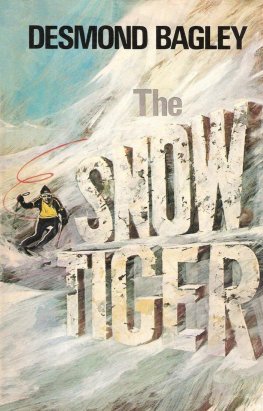
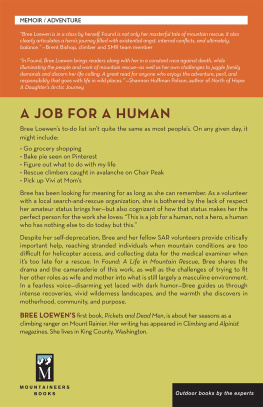
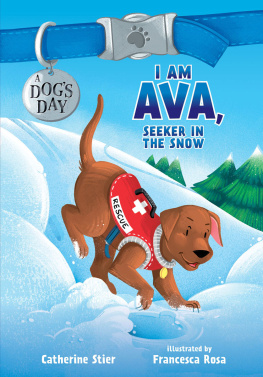
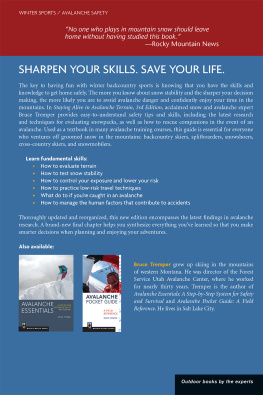
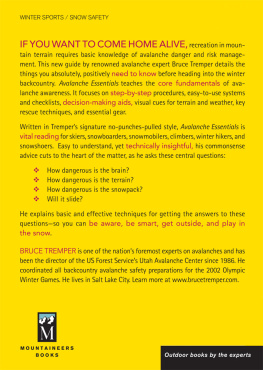
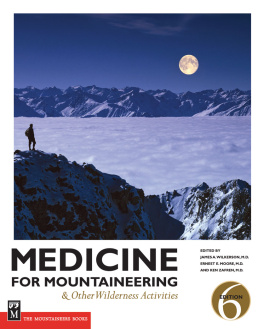
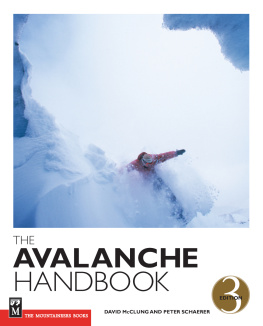



 Printed on recycled paper
Printed on recycled paper